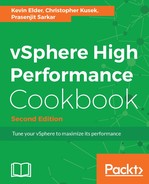Let's get started:
- For the first best practice, you need to check whether the application is single threaded or multithreaded. If it is single threaded, then avoid running an SMP VM:
- You need to log in to vCenter using vSphere Web Client, then go to the Home tab.
- Once there, go to the VM and look at the VM Hardware tile.
- Now you can see whether the VM has one vCPU or multiple vCPUs. You see whether it's using them by looking at %Utilization or a similar metric for each vCPU:

This Summary tab doesn't tell us whether the app is single threaded or multithreaded.
- For the second best practice, you need to prioritize the VM CPU using shares and reservation. Depending on the customer SLA, this has to be defined:
- You need to log in to vCenter using vSphere Web Client, then go to the Home tab.
- Once there, go to the VM, right-click on it, and then select Edit Resource Settings.
- In the CPU section, you need to define the Shares and Reservation values depending on your SLA and the performance factors.
By default, ESXi is efficient and fair. It does not waste physical resources. If all the demands could be met, all is well. If all the demands are not satisfied, the deprivation is shared equitably among VMs by default.
VMs can use and then adjust the shares, reservation, or limit settings. But be sure that you know how they work first:

- For the third best practice, you need to have a vSphere Cluster and have DRS enabled for this. DRS will load balance the VMs across the ESXi hosts using vMotion.
The first screenshot shows that the DRS is enabled on this vSphere Cluster:

The second screenshot shows the automation level and migration threshold:

- For the fourth best practice, you first need to see what virtual hardware the VM is running on; if it is not current, then you need to upgrade it. A virtual hardware version can limit the number of vCPUs:
- You need to log in to vCenter using vSphere Web Client, then go to the Home tab.
- Once there, go to Hosts and Clusters, then click on VM and look at the VM Hardware tile.
In the following example, it is version 10, which is old, and we can upgrade it to version 13.

Take a VM snapshot prior to upgrading in order to mitigate the rare occurrence of a failure to boot the guest operating system after upgrading.
For further information, refer to https://kb.vmware.com/kb/1010675.
For further information, refer to https://kb.vmware.com/kb/1010675.
- Now, to upgrade the virtual hardware of a VM, it has to be powered off. Then, start it again, right-click on VM, go to Compatibility, and then Upgrade VM Compatibility. It should give you a warning:

- Once you click on Yes, the virtual hardware version will be upgraded.

- For the fifth recommendation, you need to limit the number of vCPUs required by the VMs that would run on the host and the number of sockets/cores available in each physical host:
- Try to balance the CPU load of your VMs across all of your hosts
- Monitor the VMs for performance and adjust as necessary.
- For the last recommendation, you need to get the vendor-application-tuning guide and follow that to tune your virtual environment. A typical example is Microsoft Exchange Server 2016 Best Practices Guide.
For further information, refer to https://blogs.vmware.com/apps/2016/01/now-updated-microsoft-exchange-server-vmware-vsphere-best-practices-guide.html.
